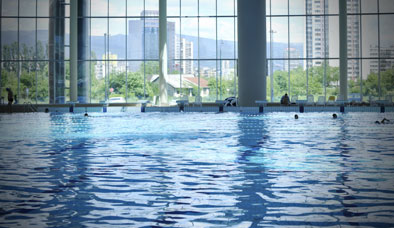
There is a lot of confusion about various filters, and many different opinions. Here are a few facts to consider. The first is that a pool can be properly maintained with any of the filter systems available: Sand, Cartridge, or Diatomaceous Earth (DE). Here is a brief description of each type:
• Sand - The bullet proof filter
Water is pushed through a bed of filter sand and removed through a set of lateral tubes at the bottom. The filter area of a sand filter is equal to the area of the filter itself.
For example, a 24" filter will have 3.14 sqft of filter area. Only the top 1" of sand is actually used to filter the water. The principle behind this filter is that water is pushed through the filter sand, somewhat like an espresso machine. Dirty water goes in the top and clean water exits out the bottom. As the filter sand becomes plugged with debris from the pool, the pressure increases on the filter and the water flow drops. In order to clean the filter, you just run it in reverse and dump the waste water; this is referred to as "backwashing" the filter. Once the filter is backwashed, you move to the rinse mode and that repacks the sand and then back to filter. This has to be done manually every few weeks. From a hydraulics standpoint, a backwash valve is typically the most inefficient piece of equipment you can add to a swimming pool system. Should the sand ever become really dirty, it is easily and inexpensively replaced. In terms of particle size filtered out, sand is the lease effective method - it can allow smaller particles to pass back into the pool.
• Cartridge - The economic low maintenance filter
This one is easy to understand. Water passes though a filter material and the filter captures the debris.
This is just like the water filters used under your sink. Cartridges have much more available area to filter than sand. Most start at 100 sqft and the majority of the cartridge filters sold are larger than 300 sqft. So they don't clog up as quickly and therefore you touch them less frequently. There are two types of cartridge filters in general. In the first case, there are filters elements that are inexpensive to replace and as such, they don't tend to last as long. Then there are other filters that have very expensive elements and these last 5 or more years. In both cases, cartridge filters are designed to run at lower pressure than sand. This puts less back-pressure on the pump and hence you get more flow and turnover for an equivalent pump size. Generally these filters have to be cleaned once or twice a season by simply hosing them off, so you don't touch them as often. In terms of particle size filtered out, cartridge is somewhere between sand and DE.
• DE - The water polisher
Diatomaceous earth is mined and is the fossilized exoskeletons of tiny diatoms. They are used to coat "grids" in the filter housing and act as tiny sieves to remove debris. They are very small and as such can filter out particles as small as 5 microns.
Diatom filter area are sized between sand and cartridge - around 60-70 sqft are most common. Once the filter pressure rises, the filter is backwashed just like a sand filter and then "recharged" with more DE powder. Typically it is poured in a slurry into the skimmer and it then coats the filter grids. DE filters run at higher pressures than cartridge filters and as such can lead to some inefficiency and flow loss.
Source: About.com
Written by About.com on 2012/08/23
